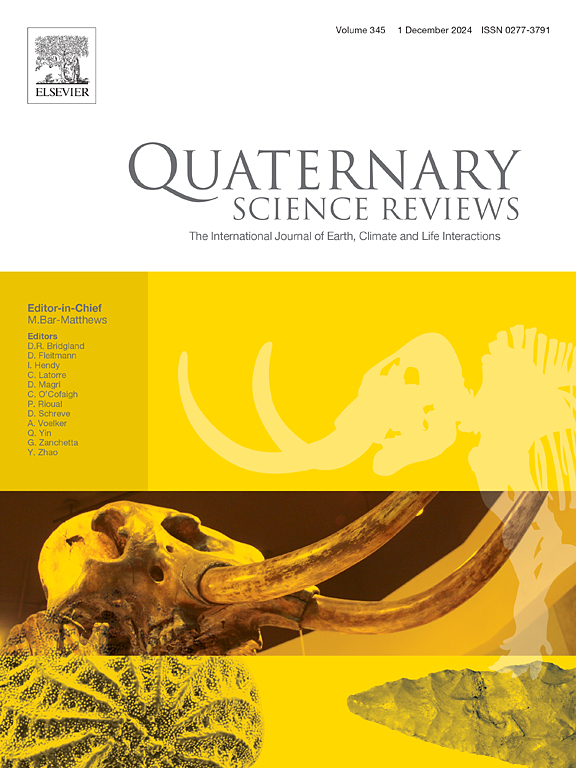Quantifying cycles of tectonically induced vertical surface motions in an accretionary wedge: evidence from foraminiferal-based Plio-Pleistocene paleo-water depth estimates of the Island of Rhodes (Greece)
IF 3.3
1区 地球科学
Q1 GEOGRAPHY, PHYSICAL
引用次数: 0
Abstract
The Island of Rhodes, located in the Eastern Mediterranean Sea at the eastern terminus of the Hellenic forearc, experienced intensive tectonic motions during the Plio-Pleistocene. Marine sediments of the Lindos Bay Formation, Plio-Pleistocene in age, were uplifted and are outcropping today along the eastern coast of the island. These sediments offer an unique opportunity to unravel the complex depositional and neotectonic history of Rhodes. In this study, we provide new paleo-water depth data from the Cape Vagia sediment section and summarize and integrate these results with existing data of paleo-water depth changes during the deposition of the Lindos Bay Formation. Paleo-water depth reconstructions were obtained by using an existing transfer function, applied to the fossil benthic foraminiferal assemblages. In doing so, the full cycle of subsidence and surface uplift of the eastern coast of the Island of Rhodes during the Plio-Pleistocene was reconstructed for the first time. Accordingly, our data indicates a maximum surface uplift of ∼700 m since the Early Pleistocene. Each of the presented sediment sections further revealed distinct short-term tectonically controlled surface uplifts with rates up to 10 mm a−1. Such rates occur regularly throughout the Plio-Pleistocene sedimentary records on Rhodes and do not seem to be related to the long-term uplift or subsidence trend of the island. Furthermore, the sedimentary records reveal differences in the timing and amplitudes of vertical motions among individual depocenters. These differences can be explained by an interplay between island-wide and local vertical surface motions, of which the latter may be due to the activity of kilometer-scale normal faults. Accretionary wedge dynamics can account for the observed temporal and spatial variations in vertical surface motions on the eastern coast of Rhodes.
在增生楔中构造诱发的垂直地表运动的定量循环:来自有孔虫的证据——希腊罗德岛上新世-更新世古水深估计
罗德岛位于地中海东部希腊前弧的东端,在上新世-更新世期间经历了强烈的构造运动。林多斯湾组的海洋沉积物,在上新世-更新世时期,被抬升,并在今天沿着岛的东海岸露出地面。这些沉积物提供了一个独特的机会来解开罗德岛复杂的沉积和新构造历史。在本研究中,我们提供了新的Vagia角沉积剖面古水深数据,并将这些结果与已有的Lindos湾组沉积时期古水深变化数据进行了总结和整合。利用已有的传递函数对化石底栖有孔虫组合进行了古水深重建。在此基础上,首次重建了罗得岛东岸在上新世-更新世期间的沉降和地表隆起的完整周期。因此,我们的数据表明,自早更新世以来,最大地表隆起约700米。每个沉积剖面进一步揭示了明显的短期构造控制的地表隆起,速率高达10 mm a - 1。这种速率在罗德岛的上新世-更新世沉积记录中经常发生,似乎与该岛的长期隆起或下沉趋势无关。此外,沉积记录还揭示了各个沉积中心在垂直运动时间和振幅上的差异。这些差异可以用全岛范围和局部垂直地表运动之间的相互作用来解释,其中后者可能是由于公里尺度正断层的活动。楔形吸积动力学可以解释罗德岛东海岸垂直地表运动的时空变化。
本文章由计算机程序翻译,如有差异,请以英文原文为准。
求助全文
约1分钟内获得全文
求助全文
来源期刊

Quaternary Science Reviews
地学-地球科学综合
CiteScore
7.50
自引率
15.00%
发文量
388
审稿时长
3 months
期刊介绍:
Quaternary Science Reviews caters for all aspects of Quaternary science, and includes, for example, geology, geomorphology, geography, archaeology, soil science, palaeobotany, palaeontology, palaeoclimatology and the full range of applicable dating methods. The dividing line between what constitutes the review paper and one which contains new original data is not easy to establish, so QSR also publishes papers with new data especially if these perform a review function. All the Quaternary sciences are changing rapidly and subject to re-evaluation as the pace of discovery quickens; thus the diverse but comprehensive role of Quaternary Science Reviews keeps readers abreast of the wider issues relating to new developments in the field.
 求助内容:
求助内容: 应助结果提醒方式:
应助结果提醒方式:


